Fil-Am artists making strides in entertainment industry
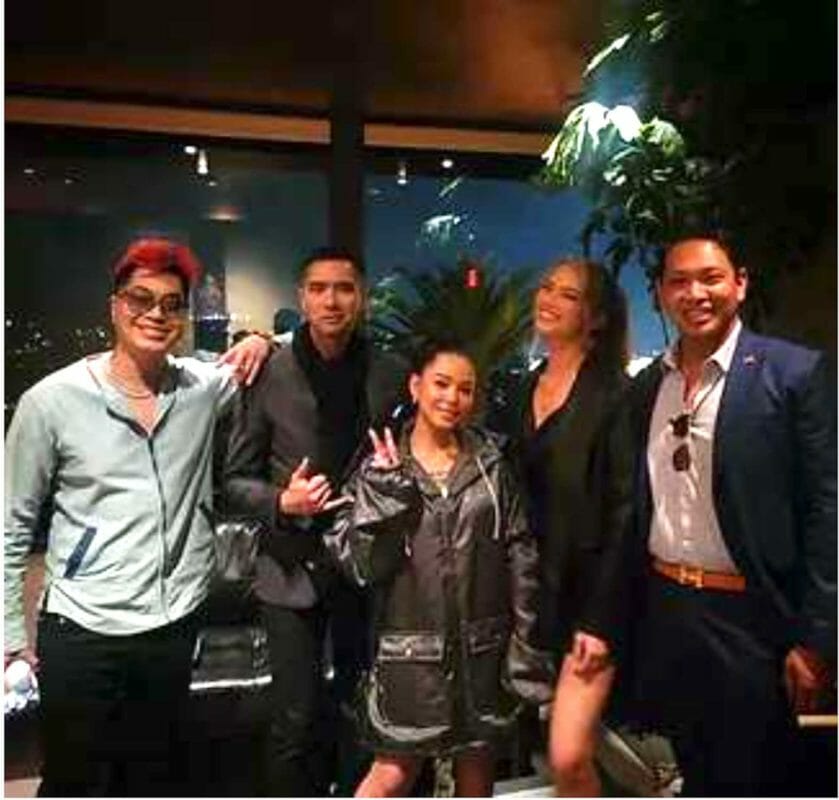
Filipino artists and those of Philippine descent have made a mark in influencing if not shaping Global Culture through their artistic creation and expression. Specifically in the United States, a great number in the performing, literary, and visual arts have made their contributions.
“Years ago, promoting history was simply found on a few blogs” says Nate Calima, a Los Angeles-based director. “Now you can see Fil-Am artists such as Bella Poarch and C-Tru dominating social media and bringing much needed attention to Filipino American history and culture.”
Filipino and Filipino American celebrities from Martin Nievera to recent ones such as Poarch and C-TRU have been dining at Yamashiro Hollywood, with meals such as lechon kawali prepared for Filipino American History Month by its new Fil-Am executive chef Valerie Archer.
In Carson, California Filipino Americans were recognized by the State of California and the City of Carson on Larry Itliong Day / Filipino American Heroes Day for their efforts to spread awareness of Filipinos’ contributions to American life.
“Before, you would need massive budgets and backing from big institutions. Now you can simply show your talent and an entire community can support you. Many did not know about our rich history that can be traced to the first landing of Filipinos on the American continent on October 18, 1587,” continues Calima.
Because of these efforts, Los Angeles landmarks such as LAX and the Natural History museum lit up with the color of the Philippine flag to recognize the movement. Artists such as AJ Rafael composed a song to bring awareness of Larry Itliong.
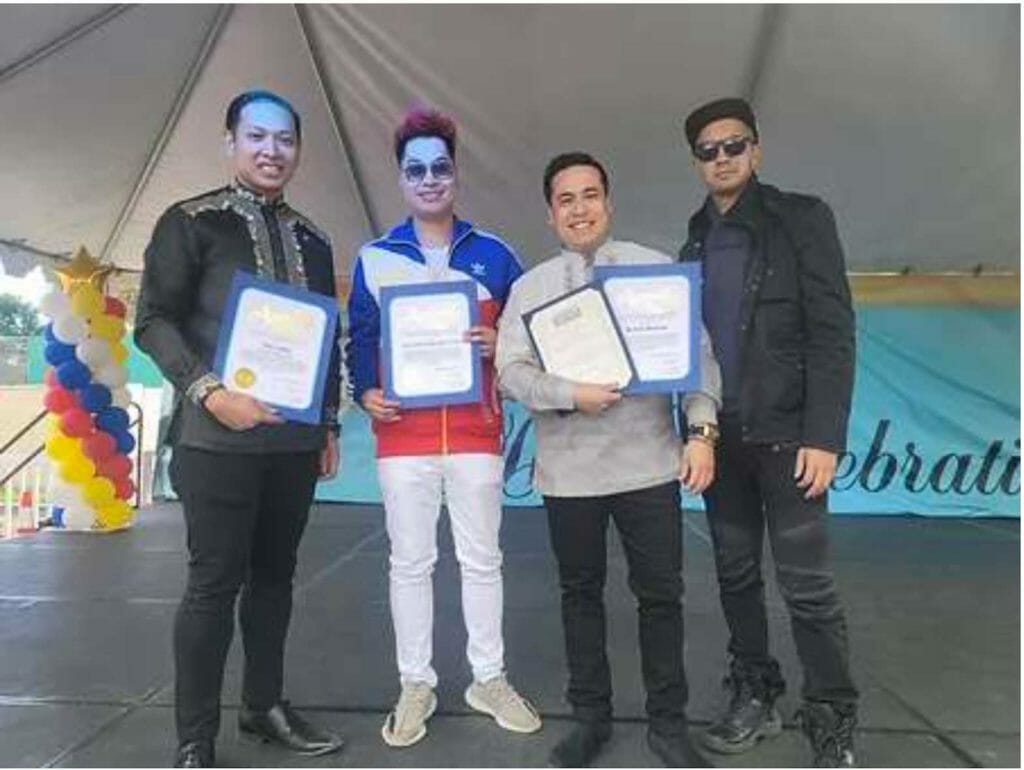 Director Nate Calima, award winning artist Carlos “C-TRU” Santos, ArcaVia CEO Richard Mendoza and Fil-Am Hollywood actor Sean Michael. CONTRIBUTED
Director Nate Calima, award winning artist Carlos “C-TRU” Santos, ArcaVia CEO Richard Mendoza and Fil-Am Hollywood actor Sean Michael. CONTRIBUTED
Whenever artists such as Saweetie or H.E.R. post on social media, a legion of proud fans bombard the comment section with Philippine emojis. These artists are glad to acknowledge their roots with more and more content that promotes Filipino heritage.
“It truly is a renaissance, thanks to a combination of offline and online efforts. As time goes on, more and more are creating content thanks to technology,” says Calima.
“The next generation of Fil-Ams are not shy about promoting their community and with the new metaverse — we will see a new generation of leadership that will be educating in virtual spaces. This will reach an entirely new audience and it has created an ecosystem of learning and leadership.”
Jorge “Jerry” Perez de Tagle, PhD, lives in the US and the Philippines. He is an author, a change management practitioner and a thought leader in the private and public sector. He taught at Syracuse University, New York.
Fil-Am artists making strides in entertainment industry
FLOURISH & PROSPER
Do we still need heroes?
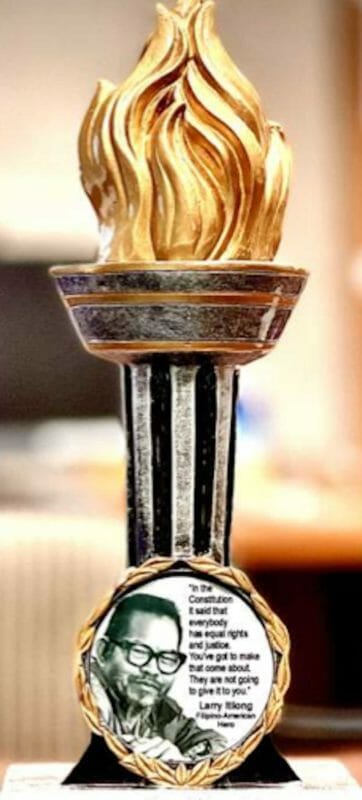
We were supposed to have, in 2020, the second coming of the “Roaring Twenties.” Roar it did as our lives went on a 180-degree spin of stops, slowdowns and its twin sisters of cynicism and fear.
Indeed, it is with real people that we know, who lived real lives, and succeeding despite the adversity and difficulty of their time, that we can be inspired to rise from our own situation. They are the real heroes of our time. The men and women who did not succumb, but fought back and won! This is the inspiration that heroes give, reminding us that we can succeed no matter what circumstance or difficulty we may face.
This is the legacy of Larry Itliong, Filipino American Hero, who helped shape the U.S. Civil Rights Movement of the ‘60s, that reverberated internationally. He inspired Filipino farm workers to take action, despite enormous difficulty, against systemic maltreatment. His leadership convinced Cesar Chavez and the Mexicans to unite instead of competing. This was exemplified in the victory of the Delano, California Grape Strike that Larry Itliong started in 1965.
Last October 25, 2021, the Filipino American Voice United, FAVU, launched the annual Larry Itliong Leadership Award, LILA, at the Celebrity Centre, Hollywood, California. Three contemporary leaders were recognized on how they exemplify the greatness of the Filipino-American Spirit: Wilfredo “Jing” Espiritu (posthumously); Noel S.V. Omega; Trinity Foliente.
It was an evening of celebration. The month of October commemorates the Philippine History Month in the United States. October 25 celebrates the birthdate of Larry Itliong and October 18 reminds us when two Filipinos first landed in Morro Bay, California, in 1587. This started the 400+ years of Filipino presence and contribution in the United States.
With the launching of the Larry Itliong Leadership Award in the United States, there is a growing awareness for Larry Itliong to be fully recognized as a Filipino-American Hero by the United States Congress and also by the Philippine Congress. Specifically, it is now timely for Larry Itliong to be recognized as the pioneering Philippine National Hero of OFWs, Overseas Filipino Workers.
Jorge “Jerry” Perez de Tagle, PhD, lives in the US and the Philippines. He is an author, a change management practitioner and a thought leader in the private and public sector. He taught at Syracuse University, New York and has his PhD in Social Change, Honoris Causa, and Candidacy in Organization Development. jerrypdt@gmail.com
Do we still need heroes?
Fil-Am Labor Leader Larry Itliong Inducted Into California Hall Of Fame

FILIPINO American labor activist Larry Itliong is among the six notable individuals posthumously inducted into the California Hall of Fame.
California Gov. Gavin Newsom and First Partner Jennifer Siebel Newsom on Tuesday, October 12, announced the honorees for the California Hall of Fame 14th class through a webcast streamed by the California Museum.
“Sometimes the Hall of Fame gives us the opportunity to bring outstanding Californians out of the shadows when their contributions to society have been largely overlooked in history books,” said Siebel. “And there is no better example of that than Larry Itliong.”
Newsom added, “We all benefit from Larry’s leadership and unapologetic advocacy.”
Itliong, according to his description on California Museum’s website, was one of the most important civil rights leaders of the 20th century and a father of the West Coast labor movement.
He was born in the Philippines and migrated to the United States in 1929, working in the Alaskan fish canneries and along the West Coast as a farm laborer.
After serving in the U.S. Army during World War II, Itliong became a U.S. citizen in 1954 and settled in Stockton, where he organized for the Agricultural Workers Organizing Committee (AWOC).
“He was so good at recruiting new members that union leaders asked him to move to Delano to organize Filipino grape workers,” noted the California Museum. “It was there that he helped change the history of farm labor.”
Among Itliong’s achievements include uniting with the National Farm Workers Association (NFWA) and starting the Delano Grape Strike and Boycott, which is one of the most important social justice and labor movements in American history.
Itliong also formed the United Farm Workers (UFW) with César Chávez, with the latter as director and the former as assistant director.
In addition, Itliong successfully secured funding for the construction of the Paulo Agbayani Retirement Village in Delano, which has provided housing and support for retired Filipino farmworkers since 1974.
Aside from Itliong, LGBTQ advocates Del Martin and Phyllis Lyon, artist Ruth Asawa, singer-songwriter and guitarist Jerry Garcia, and rock music icon Ritchie Valens were inducted into the California Hall of Fame.
“Jennifer and I are pleased to induct this group of extraordinary Californians into the Hall of Fame,” said Newsom.
“There is no doubt their lives and legacies have helped make California synonymous around the world with innovation, imagination and progress,” he added.
The new inductees joined 134 other Californians recognized for embodying the state’s “innovative spirit.”
“These luminaries represent the best of California,” said Siebel. “Each one has left their own indelible mark on history and reminds us of the creativity, ingenuity and courage that lives inside all of us.”
The California Hall of Fame was established in 2006 at the California Museum by former Governor Arnold Schwarzenegger and First Lady Maria Shriver.
Inductees are selected from all walks of life and have made distinguished achievements across a variety of fields, including the arts, education, business and labor, science, sports, philanthropy and public service.
Fil-Am labor leader Larry Itliong inducted into California Hall of Fame
October 25, 2021, Hollywood California – The 1st Annual Larry Itliong Leadership Awards #LILA, October 25, 2021 (Larry Itliong’s 108th Birthday).
I am humbled and honored to be one of the first three recipients of this annual #LILA leadership award in the U.S. Larry Itliong is a Filipino-American hero, not just to the labor movement, but to all who proudly endeavor to break through barriers that hold us back from achieving success and liberty. (Learn about Larry Itliong and his growing legacy in the United States of America and why he should be recognized all over the world.)
I am grateful to the Filipino American Voice United for this award and to my colleagues-at-arms in LAKAS America Chamber of Commerce #LAKASAmerica, the Federation of Philippine American Chambers of Commerce #FPACC #FPACCUnited and the National Federation of Filipino American Associations #NaFFAA #naffaagreaterla.
Kudos to Juanita Nimfa Yamsuan Gamez, Jerry Perez De Tagle, Peter Albano Ramirez, Rosalie Caratao, Arielle Livetv, et. al. for putting together a memorable ground-breaking event. Superbly done!
Congratulations to my fellow LILA recipients Ms. Trinity Foliente and the late great Mr. Jing Espiritu! I am humbled and honored to share the LILA platform with you.
Mabuhay!







Government Campaigns


‘Isang Tinig, Isang Lahi: One Voice, One People Live Aid Philippines’ set to raise global donations to fight COVID-19 pandemic
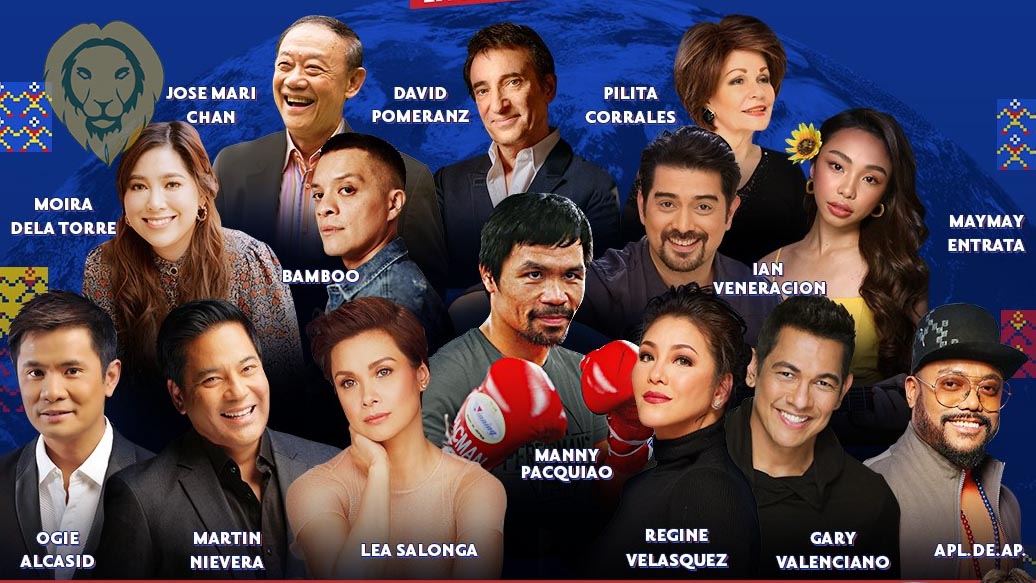
The star-studded Event top-bills Filipino musical greats Lea Salonga, Regine Velasquez, Apl De Ap, Gary Valenciano, Martin Nievera, Joe Mari Chan, Ogie Alcasid, Bamboo, Maymay Entrata, Ian Veneracion, Pilita Corrales, Moira Dela Torre and many more surprise guest artists. American musical great David Pomeranz is a special guest, lending a strong call to action. Manny Pacquaio, major supporter of the event, is expected to render some musical numbers. Celebrity musician and composer Ogie Alcasid is the overall head of production of this concert.
ABS-CBN official media partner will present the concert live via KTX simulcast on iWant TFC with delayed telecast on Kapamilya Online. The humanitarian project unites a significant number of Filipino American Associations upon the initiative and invitation of Filipino American Voice United (FAVU). Juanita Nimfa Yamsuan Gamez,
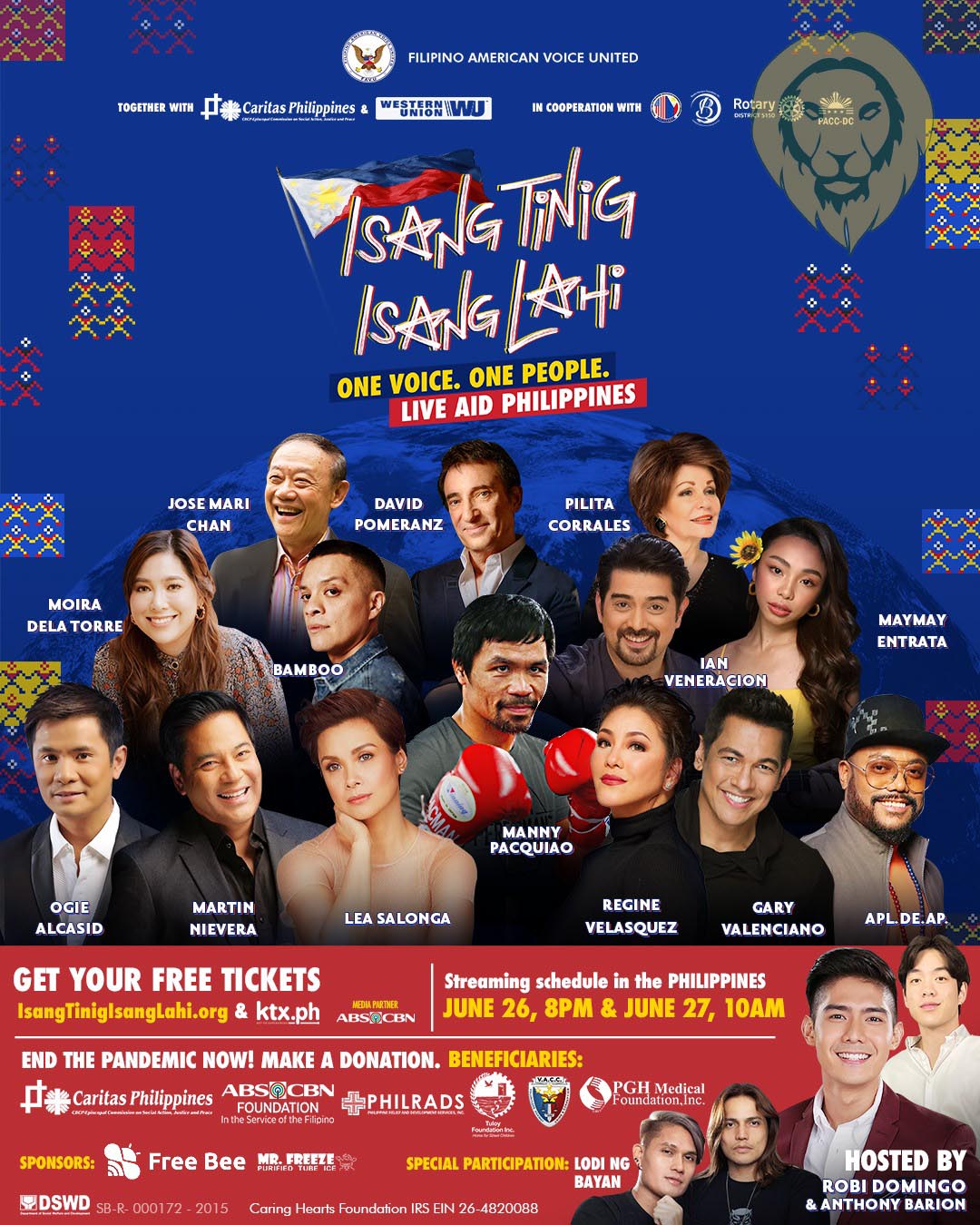
Chairman of FAVU promises that “This is only the beginning of a continuous advocacy that will embrace other urgent causes to address the needs of our fellow Filipinos.” Jerry Perez de Tagle, Vice Chairman and President of FAVU expressed his highest hopes in this milestone event: “The dream is to see a strong sense of solidarity among 5 million Filipinos in the US and 20 million-strong Filipinos worldwide.”
Multi-media personality and civic leader Cory Quirino is Project Chairman and event organizer for this dream concert. Cory sends out an earnest plea to all Filipinos here and abroad: “Let us join hearts and hands to help our kababayans in this time of crisis.”
The Concert, co-presented by CBCP Caritas Filipinas Foundation, Inc. is free to all who wish to watch. It will have a simultaneous donation-drive for the benefit of Caritas Philippines projects for the impoverished communities, the Caring Hearts Foundation, Inc. in the US, PGH Medical Foundation, Inc., Tuloy Foundation, Inc., ABS-CBN Foundation, Inc., Philippine Relief and Development Services, Inc. and Volunteers Against Crime and Corruption (VACC.) In addition, Shopee joins in the fund-raising efforts through its Special Edition Bayani, Kabalikat and Kaibigan Donor Cards.
The availability of Isang Tinig, Isang Lahi Broadcast is made possible through the 60- million reach of ABS-CBN’s digital platforms: iWant TFC, Kapamilya Online, IPTV. Broadcast Schedule as follows:
KTX.ph
June 26, 8PM Manila
June 26, 8AM North America-East Coast
June 26, 5AM North America-West Coast
June 27, 10AM Manila
June 26, 10PM North America-East Coast
June 26, 7PM North America-West Coast
TFC Linear / TFC IPTV
June 27, 2PM USA/Canada
1PM, Europe, Middle East, Africa
2PM, Asia
4PM, Guam, Australia
Kapamilya Channel / Kapamilya Online Live / iWanTTFC Philippines
Isang Tinig, Isang Lahi' Free Concert inilunsad ng Filipino Community Groups
TV Patrol: Mga bigating personalidad, sanib-pwersa sa libreng concert na ‘Isang Tinig, Isang Lahi’
Pacquiao, Quirino tell Filipinos not to lose hope during pandemic
Published June 17, 2021, 9:24 PM
(Click here to see the actual article)

Senator Manny Pacquiao urged Filipinos affected by the pandemic not to lose hope as celebrities mount a benefit concert to help fight COVID-19.
“Huwag tayong sumuko sa buhay. Habang tao ay buhay, andyan ang Panginoon na laging gagabay sa atin. Huwag tayong mawawalan ng pag-asa kasi nawalan ako ng pag-asa noon, pero hindi ako sumuko at nagawa ko ang mga accomplishments sa buhay ko. We are doing this event to help our fellowmen and give inspiration. Most of all, our Lord will give us happiness. Make sure your faith in God is strong enough so that you will have peace of mind,” said Pacquiao during a Zoom press conference for the launch of “Isang Tinig, Isang Lahi” – One Voice, One People” concert.
Multi-media personality and civic leader Cory Quirino, who is project chairman and event organizer for this dream concert, sends out an earnest plea to all Filipinos here and abroad. “Let us join hearts and hands to help our kababayans in this time of crisis.”
A historic musical concert “Isang Tinig, Isang Lahi” – One Voice, One People” will bring together renowned Filipino musical artists and international advocates as they come together in songs for a purpose to “Save Lives from Covid-19” on June 26 (Philippines/Asia) and June 27 (USA, Europe and Middle East.)
The star-studded Event top-bills Filipino musical greats Lea Salonga, Regine Velasquez, Apl De Ap, Gary Valenciano, Martin Nievera, Joe Mari Chan, Ogie Alcasid, Bamboo, Maymay Entrata, Ian Veneracion, Pilita Corrales, Moira Dela Torre and many more surprise guest artists. American musical great David Pomeranz is a special guest, lending a strong call to action.
Pacquaio, major supporter of the event, will render some musical numbers. Celebrity musician and composer Ogie Alcasid is the overall head of production of this concert.

ABS-CBN official media partner will present the concert live via KTX simulcast on iWant TFC with delayed telecast on Kapamilya Online. The humanitarian project unites a significant number of Filipino American Associations upon the initiative and invitation of Filipino American Voice United (FAVU). Juanita Nimfa Yamsuan Gamez,
Multi-media personality and civic leader Cory Quirino is Project Chairman and event organizer for this dream concert. Cory sends out an earnest plea to all Filipinos here and abroad: “Let us join hearts and hands to help our kababayans in this time of crisis.”
The Concert, co-presented by CBCP Caritas Filipinas Foundation, Inc. is free to all who wish to watch. It will have a simultaneous donation-drive for the benefit of Caritas Philippines projects for the impoverished communities, the Caring Hearts Foundation, Inc. in the US, PGH Medical Foundation, Inc., Tuloy Foundation, Inc., ABS-CBN Foundation, Inc., Philippine Relief and Development Services, Inc. and Volunteers Against Crime and Corruption (VACC.) In addition, Shopee joins in the fund-raising efforts through its Special Edition Bayani, Kabalikat and Kaibigan Donor Cards.
Ktx.ph
June 26, 8PM Manila
June 26, 8AM North America-East Coast
June 26, 5AM North America-West Coast
June 26, 10PM North America-East Coast
June 26, 7PM North America-West Coast
TFC Linear / TFC IPTV
June 27, 2PM USA/Canada
1PM, Europe, Middle East, Africa
2PM, Asia
4PM, Guam, Australia
Kapamilya Channel / Kapamilya Online Live / iWanTTFC Philippines
June 27, 9:45PM – 11:45PM
For more information, visit isangtinigisanglahi.org or contact FAVU secretariat at secretariat@filamvoice.org.
"Isang Tinig, Isang Lahi: One Voice, One People Live Aid Philippines" set to raise global donations to fight COVID-19 pandemic
ABS-CBN.Corp.Comm June 17, 2021 06:34 PM
(Click here to see the actual article)

A historic musical concert “Isang Tinig, Isang Lahi” – One Voice, One People brings together renowned Filipino musical artists and international advocates as they come together in songs for a purpose to “Save Lives from Covid-19” on June 26 (Philippines/Asia and June 27,2021 (USA, Europe and Middle East.)

The star-studded Event top-bills Filipino musical greats Lea Salonga, Regine Velasquez, Apl De Ap, Gary Valenciano, Martin Nievera, Jose Mari Chan, Ogie Alcasid, Bamboo, Maymay Entrata, Ian Veneracion, Pilita Corrales, Moira Dela Torre and many more surprise guest artists. American musical great David Pomeranz is a special guest, lending a strong call to action. Manny Pacquaio, major supporter of the event, is expected to render some musical numbers. Celebrity musician and composer Ogie Alcasid is the overall head of production of this concert.
ABS-CBN official media partner will present the concert live via KTX simulcast on iWant TFC with delayed telecast on Kapamilya Online. The humanitarian project unites a significant number of Filipino American Associations upon the initiative and invitation of Filipino American Voice United (FAVU). Juanita Nimfa Yamsuan Gamez,
Chairman of FAVU promises that “This is only the beginning of a continuous advocacy that will embrace other urgent causes to address the needs of our fellow Filipinos.” Jerry Perez de Tagle, Vice Chairman and President of FAVU expressed his highest hopes in this milestone event: “The dream is to see a strong sense of solidarity among 5 million Filipinos in the US and 20 million-strong Filipinos worldwide.”
Multi-media personality and civic leader Cory Quirino is Project Chairman and event organizer for this dream concert. Cory sends out an earnest plea to all Filipinos here and abroad: “Let us join hearts and hands to help our kababayans in this time of crisis.”
The Concert, co-presented by CBCP Caritas Filipinas Foundation, Inc. is free to all who wish to watch. It will have a simultaneous donation-drive for the benefit of Caritas Philippines projects for the impoverished communities, the Caring Hearts Foundation, Inc. in the US, PGH Medical Foundation, Inc., Tuloy Foundation, Inc., ABS-CBN Foundation, Inc., Philippine Relief and Development Services, Inc. and Volunteers Against Crime and Corruption (VACC.) In addition, Shopee joins in the fund-raising efforts through its Special Edition Bayani, Kabalikat and Kaibigan Donor Cards.
The availability of Isang Tinig, Isang Lahi Broadcast is made possible through the 60- million reach of ABS-CBN’s digital platforms: iWant TFC, Kapamilya Online, IPTV. Broadcast Schedule as follows:
Ktx.ph
June 26, 8PM Manila
June 26, 8AM North America-East Coast
June 26, 5AM North America-West Coast
June 27, 10AM Manila
June 26, 10PM North America-East Coast
June 26, 7PM North America-West Coast
TFC Linear / TFC IPTV
June 27, 2PM USA/Canada
1PM, Europe, Middle East, Africa
2PM, Asia
4PM, Guam, Australia
Kapamilya Channel / Kapamilya Online Live / iWanTTFC Philippines
June 27, 9:45PM – 11:45PM
For more information visit isangtinigisanglahi.org or contact FAVU secretariat at secretariat@filamvoice.org.
Contact:
Natividad Pagcaliwagan
Administrative Head
Mobile Number / Email Address: +63920.9155208 / netteypagcaliwagan@yahoo.com
About FAVU (Filipino America Voice United):
Filipino American Voice United (FAVU) is a non-profit organization in the US with network of offices in the Philippines, Europe, UK and Australia. Its objective is to create a reliable and secure access for financial donations from around the world with a transparent and high integrity process for funds collection and chain of custody delivery in the Philippines.
Manny Pacquiao to join PH music stars in free virtual concert
ABS-CBN News
MANILA — Boxer-senator Manny Pacquiao is set to join some of the Philippines’ top music stars in a free virtual concert produced by a US-based Fil-American organization later this month.
Billed as “Isang Tinig, Isang Lahi,” the show organized by Filipino American Voice United (FAVU) will be streamed on ABS-CBN’s digital venue KTX.ph at 8 p.m. on June 26 and 10 a.m. on June 27.
While the virtual concert can be watched for free, viewers are encouraged to include donations in their e-tickets for the benefit of Caritas Philippines, PGH Medical Foundation, Philippine Relief and Development Services, Tuloy Foundation, and ABS-CBN Foundation.

The stars align for a night of music, love and giving. Isang Tinig Isang Lahi, a free virtual global concert to help the Filipinos rise above the struggles of the pandemic. Happening on June 26 and 27 via KTX.ph. Spread the love. Share your heart. We will heal as one. Let’s help end the pandemic now. #IsangTinigIsangLahi #OneVoiceOnePeople #SaveLivesPH #MusicPantryPH #CovidPH #Covid19 DSWD-SB-R-000172-2015 — with Pilita Corrales and 10 others.
In a press conference on Thursday, “Isang Tinig, Isang Lahi” project chair Cory Quirino described the upcoming event as “a 2.5-hour musical humanitarian project that attempts to reach out to fellow Filipinos all over the world, and those who love the Philippines.”
Acknowledging ABS-CBN’s wide digital reach, she hopes that many people will watch the concert and share their blessings with those in need.
“The idea really is to heal every heart and for them to never lose hope. At the same time, in between all those messages… are the songs of these wonderful artists that are giving their talent to make the message even more heartfelt,” Quirino said.
“So every song supports the message. Iyan ang aming flow sa two and a half hours na concert,” she added.
Part of the lineup of “Isang Tinig, Isang Lahi” are Pacquiao, Lea Salonga, Ogie Alcasid, Regine Velasquez, Martin Nievera, Jose Mari Chan, Gary Valenciano, Apl.de.Ap, Bamboo, Moira dela Torre, Ian Veneracion, Maymay Entrata, David Pomeranz, and Pilita Corrales.
Top talents of Star Magic such as Kathryn Bernardo, Daniel Padilla, Liza Soberano, and Enrique Gil have also appeared in videos promoting the virtual concert.
Pacquiao, for his part, said he will perform two songs during the “Isang Tinig, Isang Lahi” event.
“Ito po ay napakalaking karangalan, to be part of this event. Maraming matutulungan ang event na ito na mga pamilya na affected by this pandemic,” he said.
When asked about the songs he will perform at the virtual concert, he replied: “Probably mga kanta ko, ‘yung ‘Lalaban Ako’ and ‘Para Sa ‘Yo.'”
FAVU chair Nimfa Gamez, for her part, said they are hoping to raise $1 million through the “Isang Tinig, Isang Lahi” show.
“One million, hindi pesos, pero dollars sana,” she said.
Open Forum Live PHLV Radio hosted by Josie Harisson, Charlotte Evans, Dolly de Leon, and Voctoria Tambunting.
Juanita Nimfa Gamez Interview of Radyo Aguila sa America
Resource Article
Waking the Fil-Am Sleeping Giant, Part 1
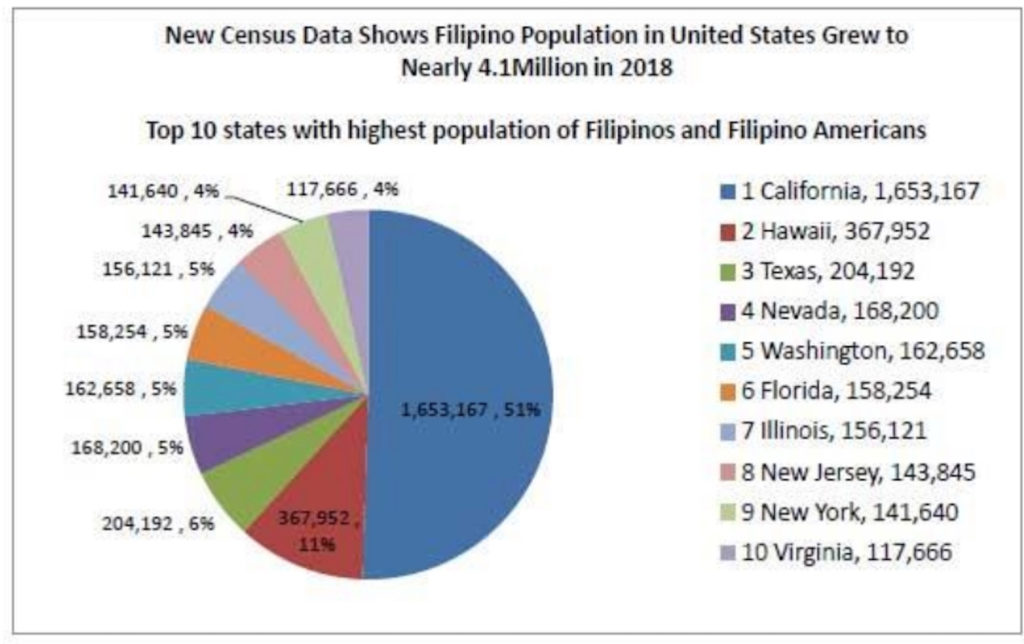
This is the first of a three-part series on Filipino American empowerment:
What an interesting conversation with my Filipino American Uber driver. She had been a U.S. citizen for 15 years, but was adamant in not getting involved and not registering to vote. Her main focus was to make money, do well, live the American dream and send money home to the Philippines. She loved the freedom and opportunity that America gave, but she did not want to get involved. Her view of U.S. politics: it was “all the same” and similar to the corrupt patronage in the Philippines. She saw the two-party system as two sides of the same corrupt coin. She didn’t see how voting could make any difference.
Why is this so?
Nearly five million “legal” Filipinos are estimated in the US. This is extrapolated from the official census 10 years ago. Most are now U.S. citizens. Many immigrated in the last 40 years that followed the waves of Filipino migration in the last 120 years.
Today, we have generations of Filipinos born in the United States and assimilated as Americans of Philippine descent. Half are 35 years old or younger. The approximate 400,000 Filipino Americans in Hawaii make up the biggest ethnic group in the state. The 1.7 million Fil-Ams in California are a constant presence with strong untapped potentials to raise their voices in the state.
But how are Filipino Americans exercising their voice and influence? The statistics show that less than half of the eligible population is registered to vote. Nearly five million- strong, Filipino Americans should at least have five congressional representatives. Today we arguably have zero representation in the U.S. Congress.
Moreover, the Fil-Am community also has the potential of influencing not only U.S. elections, but also the elections in the Philippines. This is because of the 2003 Dual Citizenship Law enacted in the Philippines. The estimate is that there are more than a million Filipino Americans who are eligible for dual citizenship. This gives them the privilege to also vote in the Philippine national elections. Instead of the mere 200,000 who cast a vote in the 2016 Philippine elections, the potential of one million voters in 2022 could be a determining factor.
It can be observed that there is a predominant sense of invisibility. The voice of the Fil-Am community is hardly heard. There are many exceptions. But the challenge and the exciting potential is in Awakening the Fil-Am Sleeping Giant from its silent slumber.
The purpose of this article, and the 3-part series, is to understand the behavior of ethnic groups like Filipino Americans in the US. Can a course of action be charted to reverse the present situation? How?
How can the Filipino American community and its youth be engaged to see their inherent potential and be empowered into action?
The short answer lies in education. It lies in shifting to a mindset that is grounded on our self-esteem and pride of identity as a people. It involves the understanding of how centuries of foreign occupation in the Philippines had led to the squelching of our voice. It is acknowledging how the virtue and valor of Filipino Americans have contributed to US nation-building in the last 400 years. It is seeing and realizing that today, our time has come!
In rediscovering our pride of identity and exceptional history, we move forward. We stand tall in continuing the legacy of our forefathers with greater contribution in society. The next two parts of this series will present the historical record, from 1587 up to the present time.
Jorge “Jerry” Perez de Tagle, PhD, who lives in the US and the Philippines, is an author, a change management practitioner and thought leader in the private and public sector. He taught at Syracuse University, New York and has his PhD in Social Change, Honoris Causa, and Candidacy in Organization Development. (FPACC). jerrypdt@gmail.com
Waking the Fil-Am sleeping giant, Part 1
Resource Article
Waking the Giant: 400+ years of exemplary Filipino presence in U.S. history, Part 2
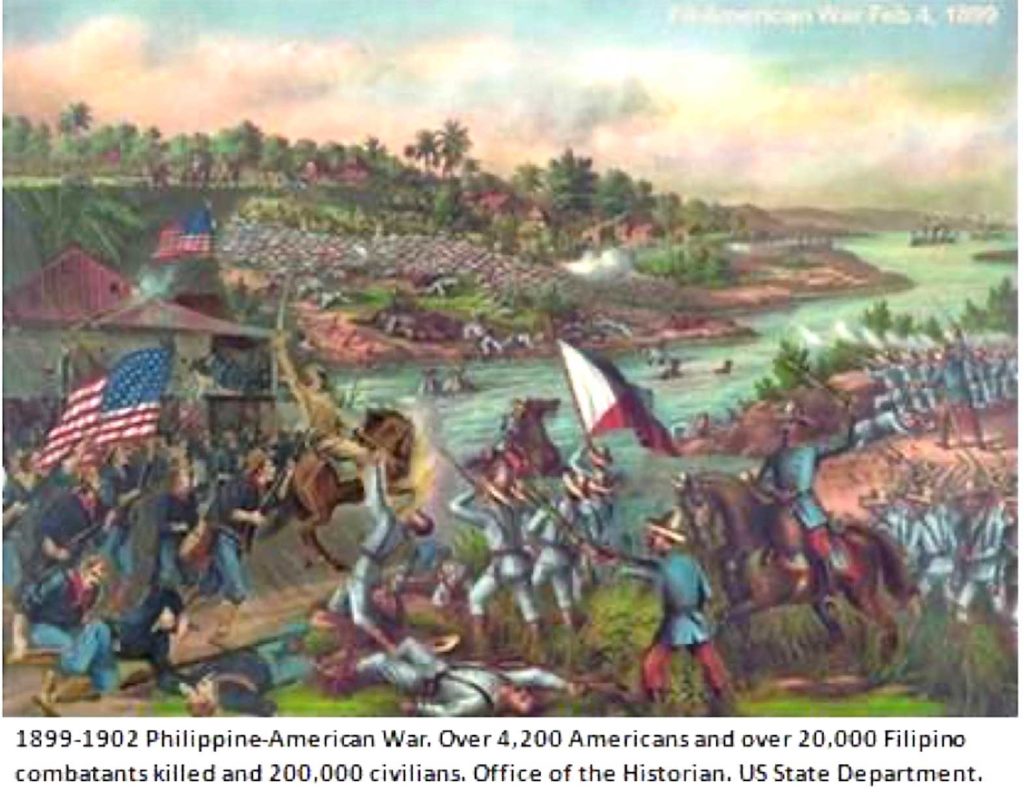
In Part One of this 3-Part series, the question of HOW to awaken the five million Filipino Americans was raised.
The short answer lies in education, in shifting to a mindset that is grounded on self-esteem and pride of identity as a people. It involves the understanding of how centuries of foreign occupation in the Philippines had led to the squelching of our voice. It is acknowledging how the virtues and valor of Filipino Americans have contributed to U.S. nation-building in the last 400 years. It is seeing and realizing that today, our time has come!
As an initial exploration, we can divide the 400+ years of exemplary Filipino contributions in the U.S. into three distinct Episodes:
- Filipino Exploration and Settlements. The first 200 years from 1587-1763.
- Filipino Freedom Fighters. The second 200 years from 1812-2014. Seven historic military milestones defines this episode. The first three are covered in this Part 2 of the series: 1812-1861-1899. The next four military milestones are covered in Part 3 of the series.
- Filipino-American Valor and Leadership. The last 100+ years from 1899-2014, present time. This Third Episode helps define the present Fil-Am identity. Four military milestones of 1911-1941-1951-2014 and two key events on 1927-1930 and 1965 arecovered in Part 3 of this series.
1587-1763 Filipino Explorers and Settlers

Did you know that the first Filipinos landed more than 400 years ago, in what is now known as California? This was 34 years before the Plymouth Pilgrims celebrated Thanksgiving in 1621.

The year is 1587, October 17, when two intrepid Filipinos called “Luzon Men” where the first to set foot on shore, in what’s known today as Morro Bay, California. The Filipinos explored the area as crew members from the Spanish Galleon Nuestra Señora de Esperanza. After a few days, one of the Filipinos was slain by local inhabitants while exploring Morro Bay.

By 1763, thirteen years before the US Declaration of Independence, Filipinos had villages known as the Louisiana Settlement in Saint Malo. More settlements evolved in Louisiana to be known as the Manila Village in Barataria Bay.
1812-2014. Filipino Freedom Fighters
Filipinos fought alongside American Patriots against the British. From different sides, Filipinos served as Confederate and Union soldiers, as adversaries in the Philippine-American War, as allies in the Korean War, and now as Commanders and Generals in the US Military.
Filipino Freedom Fighters provide a unique perspective in their contribution to the evolution and development of the United States of America. It is a nation building journey of more than 200 years, from its inception, up to today’s superpower status.
In the 1812 American War of Independence against the British “Manilamen” fought under the command of General Andrew Jackson in defense of New Orleans.

“Battle of New Orleans, where Filipino Americans, known as “Manilamen”, played a decisive role in 1815 in manning the artillery defenses, which allowed American forces to repulse enemy forces during the battle.”
1861 American Civil War. Filipino gallantry was demonstrated in both the Union and the Confederate Army.
Corporal Felix Cornelius Balderry, a Filipino-born in the Philippines served in the Union Army, with the 11th Michigan Volunteer Infantry Regiment, who fought in the siege of Atlanta.

1899 Philippine-American War
Many are not aware that the American icon and author, Mark Twain, was vehemently against the American incursion in the Philippines. It was a bloody war from 1899-1902, that killed 25,000+ combatants, (4,200-7,000 American and 20,000 Filipino). The civilian casualty and devastation due to the famine, disease, and genocidal hostilities of the war, were estimated to run from 200,000 to 1,000,000. This was an unimaginable 5-20% of the country’s 5 million population at that time. In the province of Samar occurred the Balangiga Victory by Filipinos, and the retaliatory Samar Massacre that ordered the province to be turned into a “howling wilderness…kill every one over 10”.

The imperialist and racist justification of President William McKinley was to occupy the Philippines and “civilize our little brown brothers.” This has been misrepresented as part of a $20-million colonial purchase of thr Philippines by the U.S. from Spain on December 10, 1898, in the Treaty of Paris. This marked the beginning of the U.S. as a global power.

The historical misrepresentation lies in the fact that six months earlier, the Philippines was already a sovereign nation. It had celebrated its Declaration of Independence from Spain on June 12, 1898. The Philippines is the First Constitutional Republic of Asia. What is usually omitted is that the Philippine Revolutionary Army already controlled the whole country from the occupying Spaniards; and had 15,000 troops surrounding the fort in Manila. The Treaty of Paris that ceded the Philippines to the US was illegal. Thus ensued the Philippine-American War which led to the US Commonwealth occupation of the Philippines until July 4, 1946.
Filipinos have had a pioneering and exemplary journey in exploring, living, and fighting for the democratic ideals of the United States, shoulder-to-shoulder, in most instances, with fellow Americans from 1587 to 1902. The conclusion of this 3-Part article will scan the highlights of the next 100+ years from 1901-2014; and explore how this has molded the Filipino American identity of courage and leadership.
Jorge “Jerry” Perez de Tagle, PhD, lives in the U.S. and the Philippines. He is an author, a change management practitioner and thought leader in the private and public sector. He taught at Syracuse University, New York and has his PhD in Social Change, Honoris Causa, and Candidacy in Organization Development.
Waking the Giant: 400+ years of exemplary Filipino presence in U.S. history, Part 2
Resource Article
Waking the Giant: Exceptional Fil-Am courage, leadership in U.S. nation-building, Part 3 of 3
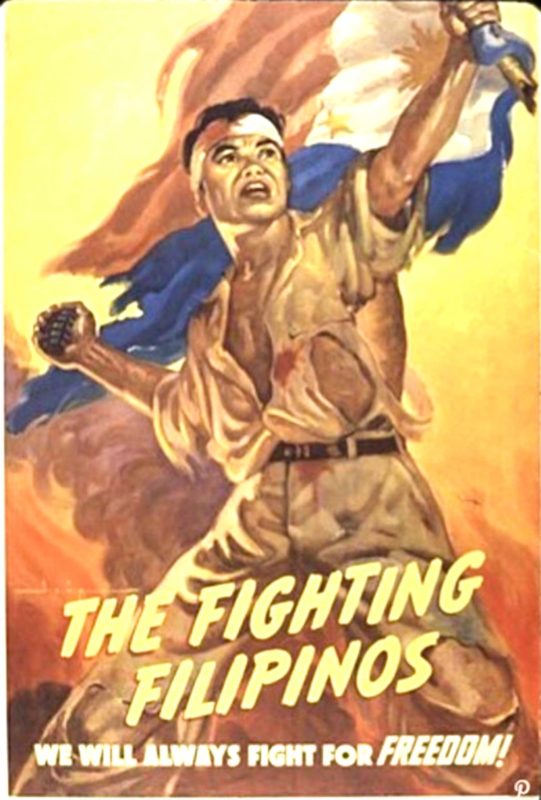
In the first part of this three-part column, we started with an observation of Filipinos and Asian Americans not fully engaged in civil society, and not registered to vote. We asked why? We asked what can be done?
By acknowledging in our identity, that we stand on the shoulders of giants; by rediscovering that Filipinos have a 400-year history of exceptional contribution in U.S. history; we stand tall with pride. As we understand and study further our 400-year history, we see in the present a new light of pride and empowerment. We are continuing the legacy of our ancestors. We Raise our Filipino American Voices in our communities, cities, states, and federal government. With empowered confidence we engage in society. We influence and lead in civil society and shape the state-national narrative. We reawaken the slumbering giant!
In this third part of the series, we review the last 120 years of contributions that now define our present-day Filipino American identity. It is an identity of courage and leadership.
Last 100+ Years
Four Fighting Filipino Milestones.
1951: Korean War-Greatest Filipino Victory
2014: First Filipino-American Commander of a Nuclear Aircraft Carrier
Two Exceptional Episodes.
1927-1930: California and Washington Racist Riots
1965: Revolutionize the Civil Rights – Farm Labor Movement in America
- The first Asian American recipient of the Medal of Honorwas awarded to Jose Nisperos for his gallantry. In 1917, as the U.S. entered World War I, the National Guard was created in the Philippines to join the war effort.

1945: Highest Distinctions in WW2 for Filipino Fighters
Among the most decorated units in World War 2 were the 1st and 2nd Filipino Infantry Regiments. Their deeds where unfortunately not widely known. The 7,000 Filipino soldiers endured discrimination during their training and where mistaken for Japanese Americans outside the base. However, their distinctions of valor and courage were unprecedented. “A total of 50,000 decorations, awards, medals, ribbons, certificates, commendations and citations had been awarded to personnel assigned to these two regiments for their service in the New Guinea and Philippines campaigns.” Wikipedia.

1951: Korean War, Greatest Filipino Victory
“The Battle of Yuldong was the greatest Filipino victory in the Korean War. A mere 900 Filipino fighting men withstood the night attack of an entire communist Chinese army that numbered 40,000 men at peak strength” (Inquirer). 7,500 Filipino soldiers were sent to Korea as Allies to the US led United Nations command. Major General Robert Soule, Commander, 3rd US Division, observed that “The ‘Fighting Filipinos’ are the best allied unit under my command.”

2014: First Filipino Commander of Nuclear Aircraft Carrier. Capt. Ronald L. Ravelo assumed command of USS Abraham Lincoln in August 2014.
The first Filipino commander of a nuclear aircraft carrier in the US Navy is indeed a historic milestone. This is in light of the more than 100-year history of racism, suppressive laws and policies that Filipinos struggled with. It is a story of success and the resilient spirit of the Filipino to succeed as well as the US spirit to transform itself.

Two Exceptional Episodes.
1927-1930. Washington – California Racist Riots and Filipino Resilience.

Filipinos in the US by the 1930s numbered around 45,000. In 1927, anti-Filipino riots in Yakima Valley of Washington took the homes and lives of Filipinos. Riots erupted in 1929 against Filipino farm workers in Exeter, California. Again in January, 1930, four days of rioting, destruction, and death were reported in the Evening Pajaronian news in Watsonville, California.
- Revolutionizing Civil Rights – Farm Labor Movements in America
Larry Itliong led Filipino farm workers in a bold Delano, California Grape strike in September 8, 1965. Larry invited Cesar Chavez and Mexican farm workers who joined the walk-out, a week later, on September 16. This was an unprecedented Filipino initiated and led farm worker strike that fought against the exploitation of farm workers.

The historic and victorious five-year strike united Filipinos and Mexicans. They fought together for farm worker rights within the broader struggle of the civil rights movement. This revolutionized the farm labor movement in America and around the world. Larry Itliong passed away in 1977. Cesar Chavez later gained international acclaim for the Delano Strike and its impact in unionizing farm workers around the world.
What is exceptional here is the historic coalition of the Latino-Mexican farm workers and Filipinos. In solidarity, victory was achieved. Filipinos, also referred to as Asian Latinos, showed success in solidarity.
It is also worth noting how Filipinos share a similar history of colonization, and oppression with Asians, Latinos, African Americans, and Native Americans. There is a natural solidarity with people of color. This was also seen in 1901 as Filipinos fought together with African Americans who joined the Philippine ranks during the Philippine American War.

CONCLUSION
We have from 1587-2014, a broad summary that acknowledges the proud legacy of previous generations. A comprehensive review of further Fil-Am contributions in the arts, science, and commerce is the subject of a future article. This 3-Part series is a starting exploration, that aims to question existing perspectives with a new narrative.
Hopefully this will spur debate, discussion, and deepen the primary source research. The goal is to shift into a new mainstream narrative and perception, of what it means today to be a Filipino American. The strength, self esteem, courage, and leadership of the Filipino American runs deep. It runs in the veins of the present generation, from the literal blood, sweat, and tears of our ancestors.
Today, Filipinos make up the third largest immigrant population in the US, after the Mexicans and the Chinese. The task at hand for the present generation of Fil-Am leaders is to rediscover, shout out loud, and institutionalize in our schools and community culture, our passion and pride: The 400-Year History of Exceptional Filipino Contributions in the United States.
Jorge “Jerry” Perez de Tagle, PhD, lives in the US and the Philippines. He is an author, a change management practitioner and a thought leader in the private and public sector. He taught at Syracuse University, New York and has his PhD in Social Change, Honoris Causa, and Candidacy in Organization Development.
Waking the Giant: Exceptional Fil-Am courage, leadership in U.S. nation-building, Part 3 of 3
Resource Article
Crab Mentality- Where does it come from?

Can the “crab mentality” of disdaining the success of others ever change? Is this behavior unique to Filipinos? Or is it also seen among other Asians, Latinos, and communities who have had a history of being oppressed?
Johnny, a Filipino, is an upcoming success in his career-business and with his community. He is beginning to be recognized. However, there seems to be a negative backlash and unfounded criticism of Johnny that’s coming from other Filipinos. Instead of lauding and supporting Johnny, some fellow Filipinos seem to disdain him.
Is this the classic “crab” behavior? (Crabs in a bucket pull back the other crabs who are moving ahead.) Where is this coming from? Can this be changed?
Studies in human behavior show that one’s crab mentality comes from a personal insecurity or low self-esteem, which is usually unknown to the individual. It may be that the feeling of disdain, jealousy, and antagonism is justified. There is usually a sense of being self-righteous and virtuous. But, why is this behavior prevalent in particular societies? I have seen it across the various cultures and countries. It seems to be common with societies and groups that have experienced suppression, bullying, and oppression for a period of time, across generations and decades, if not centuries.
Crab mentality is learned as part of societal acculturation, adaptation, and survival. It is learned by parents and elders to suppress the success-linked behaviors of their children and of newcomers in a tribe. This is the adaptive behavior of the family to survive and escape the wrath of the masters in the community. Intelligent and success behaviors in children were seen as dangerous for the people who held power. The masters who wielded power over the group knew that intelligent and self-determined children would grow up to question, rebel, and subvert the existing power structure of the community.
Understanding the behavior is not meant to justify it but to have society, family, organization, and the individual create the appropriate solution in order be free of this behavior.
Once revealed and seen as dysfunctional behavior that doesn’t serve the goals of the individual or group, a new behavior can be consciously taken. A change in culture can be managed. Societies do this by enacting laws that conform to its moral code.
Organizations explicitly identify their Core Values and Code of Conduct to define their group culture and how they aspire to communicate and treat each other. Disciplinary Action, reprimand, and expulsion from group membership can be exercised for those deemed to be miscreants. Undoubtedly, this can also be abused by the group. Imperfect as it is, a Code of Conduct and Core Values are the ethics, ideals, and aspirations that enable group self-management.
As a practical example, what follows below is a draft of the Code of Conduct and Guiding Principles of the FilAmVoice. US to address undesirable behaviors of crab mentality, gossip, corruption, character assassination, and divisiveness.
CORE VALUES: (Timeless. See Code of Conduct)
Vision and Values Led
Integrity and Transparency
Inclusive, Bayanihan, and Communication
Servant Leadership
CODE OF CONDUCT & GUIDING PRINCIPLES:
Vision and Values Led
“The act or power of anticipating that which will or may come to be. A vivid, imaginative conception or anticipation”;
“Adherence to moral and ethical principles; soundness of moral character; honesty.“
- A bias for action is leadership from a desired Vision of a future. This Vision is not necessarily defined by the limitations of the present nor by the considerations of the past. It is a conscious choice for optimism-positivism and not for negativity-pessimism.
- The foundations of our rock-solid unity to overcome rancor and disagreement, is based on the strength of our common vision and the confidence on our shared values — for Family, Freedom, and Faith. We strive for unity, and compromise when necessary. We address conflicts from the greater good of our common vision and values.
Integrity and Transparency
“The state of being whole, entire, or undiminished”;
- Deepen the research and understanding of Fil-Am contributions. Celebrate the 400 years of Fil-Am exceptionalism in US history. Inculcate Fil-Am pride of identity and history of victory over suppression and oppression.
- Transparency of intention, agenda, financial income-expense, and clarity of measurable outcomes are crucial. Conflicts of interest are handled with full disclosure and transparency. Colonial legacies of corruption are overcome by setting an example of the highest ethical standards. Valor-virtue-values are the foundations in raising the Fil-Am voice of undiminished integrity.
Inclusivity, Bayanihan, and Communication
- Build a culture that is inclusive. Individuals and groups of Filipino descent, racially and ethnically are welcome. Membership is open to anyone who is aligned and committed to support the vision and values of the Fil-Am Voice USA Movement. All Philippine tribes, (a group or class of people with strong common traits, values, or interests), languages, ethnicities, regions, provinces, religions are acknowledged.
- Bayanihan(the spirit of communal unity and cooperation) volunteerism and initiative is the Filipino term of helping and supporting each other and the community to succeed. Create a culture of recognition that edifies (uplift, build up) each co-volunteer and leader. Consciously eradicate any colonial vestige of “divide and rule-crab mentality” and back biting. We focus, accept, work with, and build on the talents, strengths, and capability of volunteers; and not on their limitations.
- Seek to live with the truth through primary source, direct experience-communication and not through secondary source hearsay. Differences of viewpoints, analysis, and opinion are settled through Servant Leadership communication and edification. There is a specific focus to avoid any colonial vestige of ad hominem (Attacking an opponent’s character or motives rather than answering the argument or claim. Appealing to one’s prejudices, emotions, or special interests rather than to one’s intellect or reason.) and personal criticism.
Servant Leadership
“It begins with the natural feeling that one wants to serve, to serve first. Then conscious choice brings one to aspire to lead.” Robert Greenleaf
10 Principles:
Listening, Empathy, Healing, Awareness, Persuasion, Conceptualization, Foresight, Stewardship, Commitment to the Growth of People, and Building Community. (The Journal of Virtues & Leadership)
Jorge “Jerry” Perez de Tagle, PhD, lives in the US and the Philippines and is an author, change management practitioner and thought leader in the private and public sector. He taught at Syracuse University, New York and has his PhD in Social Change, Honoris Causa, and Candidacy in Organization Development.
Crab mentality – where does it come from?
